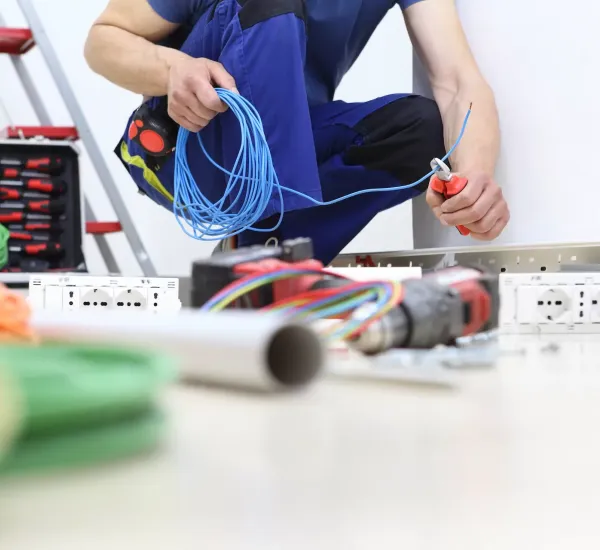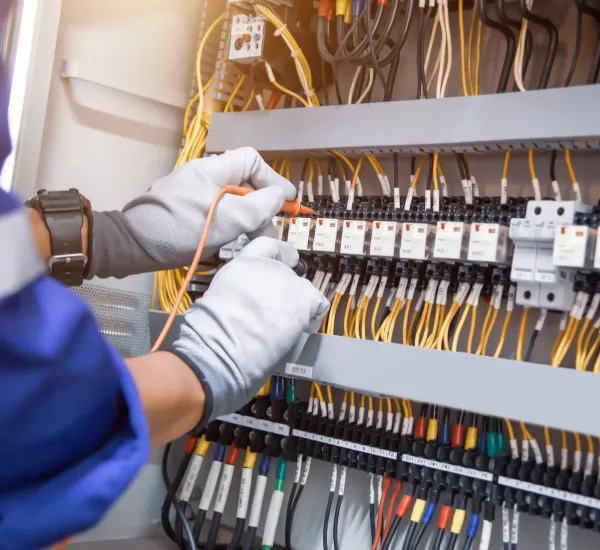Call Today!
Electrical Installation

Electrical Systems
The health of your electrical system my rely heavily on the quality of its wiring.
Electrical Wiring is an important part of a building, be it a residential building (individual houses or apartments), large commercial spaces (office buildings) or industries (factories).
There are several methods and systems of electrical wiring, which are used for lighting and other power circuits.

Professional Electrical Installations
Proper wiring systems utilizing any variety of electrical wiring types will comply with electrical safety codes, certified by organizations such as the national fire protection association.
To ensure your project is up to national electrical code, it’s a good idea to hire a professional.
Electrical equipment needed for a new wiring system is similarly varied and includes items like a voltmeter or multimeter, a non-contact voltage tester, and fish tape.
These wiring materials are less accessible to the DIYer, even if performing residential wiring inside of your own home.
To ensure your light fixtures and properly installed, and to avoid damage to any existing wiring, it’s a good idea to call in the experts.
Types of Electrical Wire
Cleat Wiring
Cleat wiring is a cost effective and straightforward wiring system that consists of VIR or PVC insulated wires, which are commonly weather-proof sheathed cables.
Cleat wiring is often a temporary wiring system used during the initial construction of projects. Therefore, they are held by wood, plastic, or porcelain cleats on the ceilings and walls.
Branches or solid wire are braided and compounded. They are held on walls and ceilings using porcelain cleats with groves, wood, or plastic for enhanced circuit protection.
Knob & Tube Wiring
As the name suggests, insulated cables are put into a flexible plastic jacket and are covered with a cap.
While PVC is usually used, VIR and other approved insulated electrical cables could also be used in this kind of electric wiring.
Conduit Wiring
Conduit Wiring is when the wiring is installed within the wall along with metal or plastic pipes. These can be divided into two different types:
- Surface Conduit Wiring: This is when GI or PVC conduits are installed on a surface. Generally, this can be the walls, the ceiling, or the roof. The conduits are sealed within the walls at equal distances.
- Concealed Conduit Wiring: This is when conduits are plastered and hidden inside wall slots. While Conduit Wiring may seem like a popular choice among homeowners, it is essential to know their advantages and disadvantages.
Advantages:
- It is a long-lasting electrical wiring system
- There is no need to have any safety concerns such as getting shocked as electrical wires are not directly exposed to you
- There is no risk of it getting harmed by the chemical effects of external factors like moisture or humidity
- Its functionality does not come in the way of being aesthetically pleasing
- There is no risk of attaining damages to the cable insulation, which decreases the chance of fires.
Disadvantages:
- The price is higher as compared to other electronic wiring systems, surface conduit wiring included
- Installation and wiring is complicated, so therefore addition and management of conduits will be difficult
- Defects and faults are challenging to find
Copper Wire
Known for being highly conductive, copper wiring is used in many kinds of electrical wiring. Copper has the lowest resistance to the flow of electricity of all non-precious metals.
Electrical wiring in buildings is the most important market for the copper industry.
Advantages:
- Conduction: Copper, second only to silver, is one of the most conductive materials of electricity there is.
- Corrosion Resistant: Copper has a high corrosion resistance that reduces the risk of deterioration.
- Malleable: Copper can be bent into any shape or direction without snapping.
Disadvantages:
- Cost: Copper costs far more than fiber optic cable.
- Corrosion: One of the most serious disadvantages of copper wire is its susceptibility to corrosion.
- Shock Hazard: Fiber optic cable has a lower shock hazard than copper wire.
Integrity Electrical & Controls Systems
At Integrity Electrical & Controls Systems, we provide Tucson with full-service residential and commercial electrical installation for new construction, renovations, investment properties, exterior and interior wiring, landscape lighting, service upgrades, and more.
From design to finish, our experienced team will ensure satisfaction with a job well done – the first time!
Stop your search for a Tucson electrician today. Call or click below for a quote from Integrity Electrical & Controls Systems!